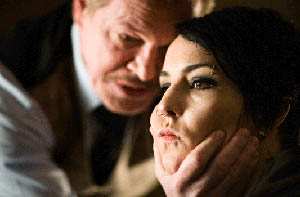|
This is probably the most talked about thriller in recent years, an astonishing fact considering that it's in Swedish and if Americans hate anything, it's having to read (Don't believe me? Look on the Internet and honestly try to convince yourself that any of that garbage was written by someone who's ever cracked a book in his or her life). At its heart is the sort of mystery structure I tend to find enthralling, full of ciphers and imperfect glimpses into past enigmas that are all the more compelling because of their imperfection. Alas, stacked around this core is a lot of material that's sadly obvious and manipulative, and which really should have found a less clever movie to go and stomp around in. 
Forty years earlier, a young girl from a wealthy family vanished without a trace. Repeated investigations over the years notwithstanding, Harriet Vanger has never been found, and no killer has ever been identified. Despite the seeming hopelessness of the mystery ever being resolved, Harriet's uncle Henrik approaches Millennium magazine reporter Mikael Blomkvist with an offer of hiring the journalist to ply his skills at finally solving the hopelessly cold case. Harriet vanished from an island accessible by a single bridge that was blocked the day she vanished, and Henrik believes this leaves only his own family to populate the list of suspects. Mikael himself is facing a short prison stint for a case of libel, for which he believes himself to have been set up. The prosecution's primary source of information on Mikael, a skilled computer hacker named Lisbeth Salander, believes likewise. She's the eponymous girl, though she honestly isn't the lead, whatever the marketing would have you think. Eventually, her still-open link to Mikael's computer clues her in on his investigation of the Vanger family, and gradually, the two form a tentative partnership, each possessing valuable skills that could finally provide an answer to the mystery of Harriet's disappearance. I've never read any of the trilogy of books by author Stieg Larsson, so I can't say what might have been changed or tweaked for the film incarnation. However, there are scenes here that are so blazingly cinematic it's hard to really imagine them coming to full fruition in a print medium. At one point, Mikael finds a roll of film shot by a newspaper photographer of a public event occurring just prior to Harriet's disappearance, the last physical evidence of her existence. Sequencing the images and setting them into motion on his laptop after enlarging the pertinent area, he discovers an invaluable clue to the puzzle; one is reminded of similar scenes in Blow-up, or Blow Out, or some film with "blow" in its title, other than the film Blow, which was about cocaine. In sequences like this, the film shines, illustrating just why these sorts of stories grip our imaginations-it's almost a form of time travel, a murky window into events now unreachable but still unresolved and needing full definition. Other, more literary-friendly clues further suggest that Harriet was herself involved in an investigation of sordid, contemporaneous events. Did she, in the parlance of the thriller, know too much? 
Though clearly the narrative second banana to Mikael, it's Lisbeth Salander who has commanded the bulk of the attention in the press and analyses, and it's reasonably understandable as to why: she's as fiery and unsettled as Mikael is low-key and level-headed. A ward of the state following a violent act she committed as a child, she's withdrawn, ferocious, resourceful, visually outlandish and full of personal tics which often go unexplained; in short, Lisbeth is the sort of stuff film icons are made of. That said, it's in its treatment of her that the film reveals a starkly manipulative streak. Lisbeth is graphically brutalized on repeated occasions in a series of bluntly disturbing scenes that are totally irrelevant to the overall plot, so that we can later cheer her revenge. This is the storytelling equivalent of bowling, setting up a series of misogynistic assholes with no redeeming traits soley for the purpose of knocking them down. The original title, apparently hailing from the Snakes on a Plane school of naming, was Men Who Hate Women, making the intentions here a bit more obvious. Lisbeth Salander has been frequently touted as some sort of feminist hero, though if casting a girl-or for that matter, women in general-as a perennial victim so she can gratify the audience with payback counts as feminism, then I Spit on Your Grave must be some sort of feminist masterpiece. Frankly, there are images in this film that bothered me for days afterwards, and while some might trumpet that as some kind of achievement, it's not one for which I'm going to be doling out any 'thank-you's. I don't, to put it simply, watch movies so I can feel like crap later. The other main problem with the film is less philosophical and more practical: after luring us in with such a dazzling breadcrumb trail, ultimately the answer to "whodunit" is appallingly obvious; I'd fingered who'd done it within ten seconds of the character's appearance. With so many thrillers in existence, attempts at misdirection have ever more frequently become flashing neon signs of revelation. Of course, it's entirely possible that you won't guess the end preemptively, but I'm not sure that visiting the story's more entrancing aspects is worth the experience of enduring its thoroughly unpleasant ones. It's often fascinating, but despite its vintage Agatha Christie pedigree, it's not too much fun. -review by Matt Murray
|
|
||||||||